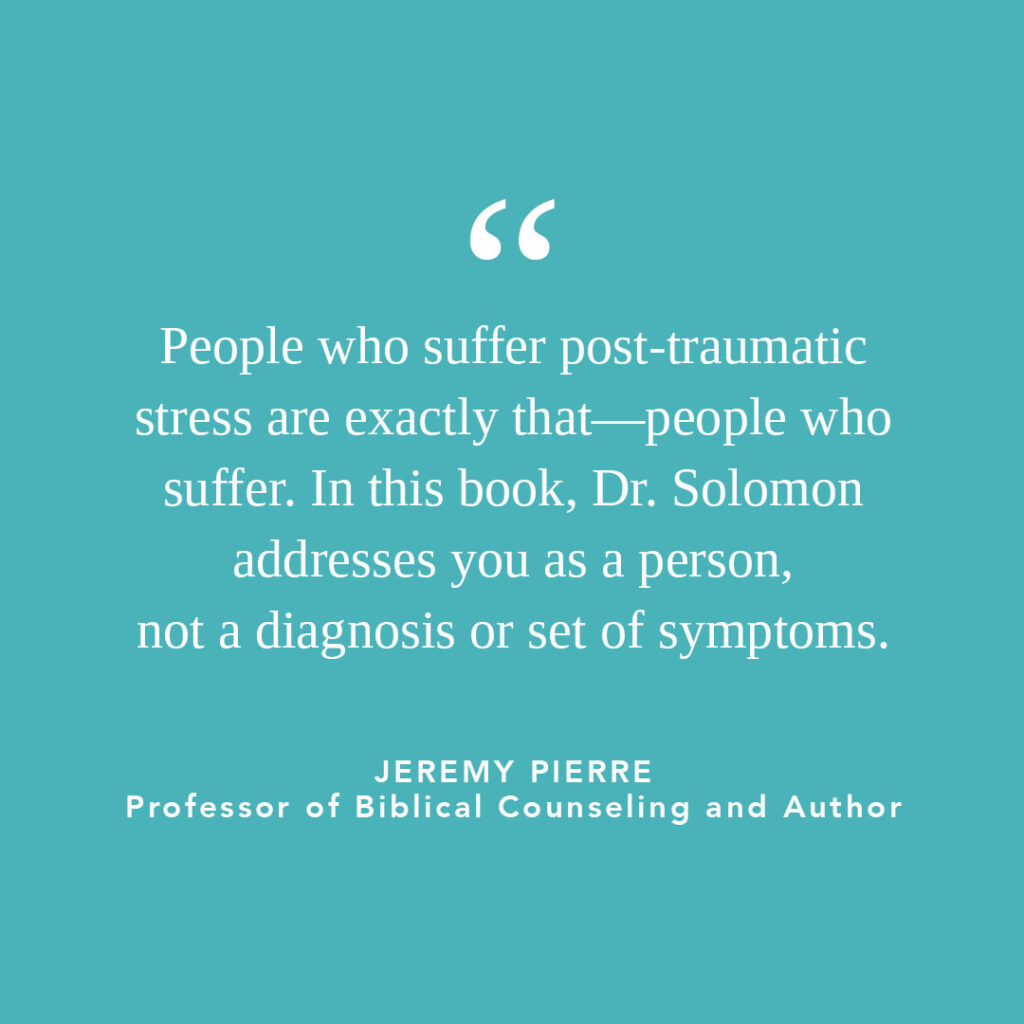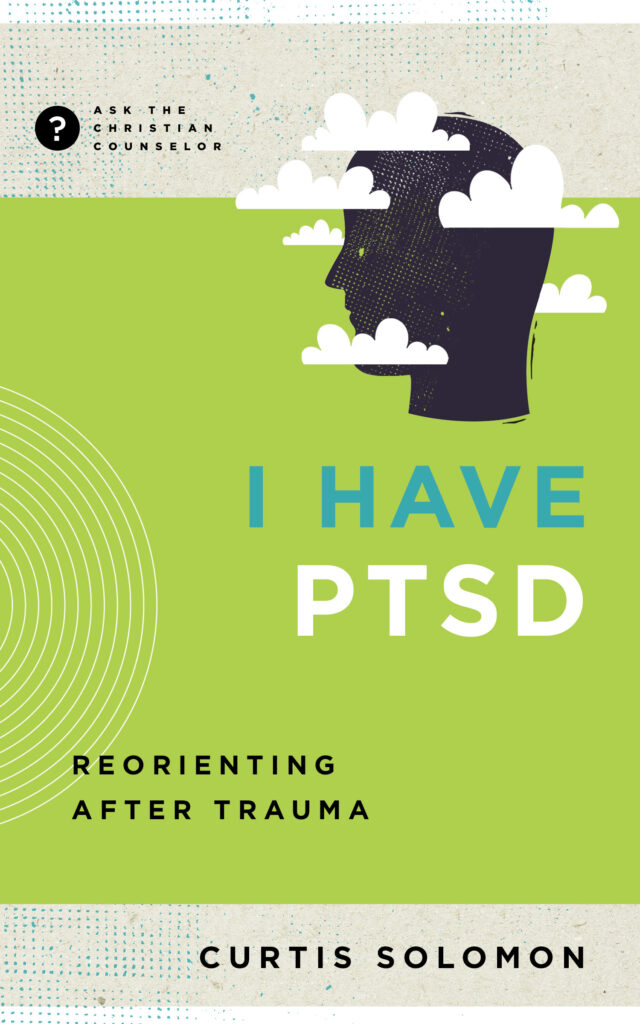Anyone who experiences a traumatic event feels confused, lost, out of control, unsure, and unsteady—disoriented. This kind of suffering leaves marks, sometimes on the body, always on the soul, and sometimes both. In I Have PTSD: Reorienting after Trauma, counselor and trauma expert Curtis Solomon helps those who have suffered the disorienting effects of trauma to reorient their lives to the path God has for them.
I Have PTSD gives readers the tools to understand their struggle and how the gospel brings hope and healing to post-traumatic stress. Curtis helps both those who have suffered trauma, as well as their loved ones, to understand the physical, emotional, and spiritual effects of trauma while offering practical ways to make that hope real in their lives.
In this interview with Curtis, he shares what PTSD is, the signs to watch for, and hope and help for moving forward.
Q: When we hear “PTSD,” we often think of someone who may have been in military combat, but trauma can encompass so many different experiences. What other situations might result in someone experiencing post-traumatic stress?
Great question. It is vitally important that people understand PTSD is not a military issue, a law enforcement issue, or an issue of any particular population. PTSD is a life issue. People experience post-traumatic stress after encountering all sorts of events that threaten to (or actually do) end life, cause serious bodily harm, or violate one’s sexuality. These experiences can encompass anything from a motor vehicle accident, a violent crime, watching a loved one die, living through natural disasters, and more. The list could go on and on.
Q: The word that you use to describe what a trauma does to a person’s life is disorient. For someone who may not have experienced trauma, please explain how its impact can be disorienting.
Disoriented is the best single word I can think of to describe the experience of PTS. It carries the concepts of confusion, disruption, and instability: having what was once set and stable completely turned upside-down, tossed about, or shaken up. It simultaneously feels like you have been hit by a wave, driven under the water, and rolled about until you don’t know which way is up. It is the sensation of being out in the wilderness and completely lost.
Q: What is a transformation team? Why is it important to have an entire team walk alongside you?
God says it best, that it is not good for man to be alone (Genesis 2:18). From the beginning, God declared our need for relationship, our need for one another, and he made that declaration before the universe was corrupted by sin. The enemy understands this reality and seeks to isolate people in whatever struggle they have. With trauma, the lie that screams loud and clear in the sufferer’s mind is, No one knows what I’ve been through. No one understands me. No one can help me. As Joni Earekson Tada says, “Community breeds life. Isolation leads to death.”
A transformation team is a group of people that comes alongside the sufferer to offer hope, encouragement, friendship, and care. They include a biblical counselor, a spiritual mentor or friend, and 3–5 other people who aren’t necessarily privy to all the details of the person’s struggle but who know there is a struggle and have been equipped with some interventions to help the person in key moments of need.

Q: You write that no two people experience trauma in exactly the same way, even if they lived through the same event, because they will have different responses and wounds as a result. However, there are common symptoms of PTS. What are some of the signs that loved ones can watch out for?
Trauma is instigated by events of severe suffering. So, the first thing to note is you should be close enough of a friend or family member to know that severe suffering has occurred. If you aren’t that close of a friend, you may not be the one to intervene, unless the person specifically asks you.
If someone you know has been through something that threatened her life, serious injury, or violation of sexual integrity, then stay close enough to observe her responses. In the immediate aftermath, ensure she is eating, drinking water, and sleeping. As time progresses, observe and ask about things like sleep loss, including nightmares, waking up in fright, or difficulty in falling asleep and staying asleep. Watch for increased irritability, jumpiness, a loss of interest in things she used to love, a change in personality, or a desire to isolate. She might try to avoid things that might remind her of the trauma or have a threat response (fight, flight, freeze, faint) to things that are not actually dangerous. She may express negative thoughts about self, life, God, others, the world, especially if that is a change from previous outlooks on life.
Q: You are intentional to use the acronym PTS or PTSd rather than PTSD in the book. Why do you make this distinction?
The “D” in PTSD stands for disorder. That label often communicates to people that they are disordered, broken, weak, or freakish. This diagnosis, combined with the common prognosis, “There is no known cure for PTSD. It is something you are going to have to learn to live with,” robs people of hope.
The reason I prefer PTS over PTSD is that it is less a diagnosis and simply a description of experiences that are common to people who live through severe suffering. I want people to understand that what they are living through is not a broken, abnormal response to normal life, but a common response to extreme suffering.
Q: How does looking at the life of Jesus and how he handled himself provide hope and perspective for the traumatic events we have faced?
Jesus is the exemplar human in all respects. He is the embodiment of what we were created to be. When we look at how Jesus suffered, there is a great deal to learn. First of all, his life teaches us that Jesus understands, relates to, and feels for us in our suffering.
Second, we see that Jesus suffered severely and expressed whole person lament for the pain and difficulty he went through. He did not “tough it out,” “suck it up,” or keep to himself. He cried out with loud cries and tears toward someone—his heavenly Father. We are to follow that example of going to God with our griefs and grievances.
Finally, Jesus’s suffering drew him toward people in compassion and love. It did not drive the wedges of hardness, comparison, and looking down on others. We should follow his example by being softened toward others who are suffering and looking for ways to help them—sharing the hope and help we have received from God in the midst of our own pain.
Q: What is a peace plan? Does everyone who struggles with PTS need one?
The peace plan I describe in the book is vital for anyone who struggles with panic attacks or similar fear responses. But it is also a helpful tool for anyone who struggles with anxiety or fear of any kind, which is really all of us. It is a tool that helps us live out Philippians 4:4–9.
A peace plan is designed to help you reestablish peace with God and with your inner and outer person. It invites God and others to aid you in the pursuit of peace. The basic steps are intentionally simple but profoundly helpful. Pray. Recline. Breathe. Think. Call.
Q: Regardless of the type of trauma one experiences, there is always some kind of loss. What are the biblical steps of grieving a loss?
I’m completely indebted to Bob Kellemen for the insights he shares in his book, God’s Healing for Life’s Losses. It is my go-to book for counseling someone who is experiencing grief. Bob outlines eight phases of grieving from God’s Word:
- Being honest with yourself about the pain
- Being honest with God
- Asking God for help
- Receiving God’s help
- Trusting with faith
- Groaning with hope
- Perceiving with grace
- Engaging with love
Q: Guilt and shame often plague trauma survivors, but it’s important to differentiate between the two terms. What are the differences?
People will use these terms in a variety of ways—sometimes interchangeably and sometimes with very clear distinctions. Whenever you are conversing with someone about these matters, be sure to ask clarifying questions to be sure you are talking about the same things.
The way I distinguish these terms is that guilt is an objective reality. Biblical terms used for guilt are typically judicial terms. Someone has violated God’s law, and they are objectively guilty before the ultimate judge.
Shame has more to do with the internal experiences associated with sin, whether it be shame over my own sin or shame I feel because of something done to me. Shame can also have something to do with disgust, even if guilt isn’t involved.

Q: When it comes to resiliency, how are trauma survivors similar to trees?
There are three common ways people talk about resiliency: resistance, recovery, and reconfiguration. Each of these responses is similar to the way a particular type of tree responds to the strong winds of a storm.
- Resistance is the ability to be unaffected by suffering. This is like an oak tree. No matter how strong the wind is, that trunk is not going to bend.
- Recovery is the ability to “bounce back” after a trial, similar to how a palm tree will bend in the storm but it straitens back up after the storm passes.
- Reconfiguration is the tendency to adapt oneself in and after a trial, typically in a way that is better equipped to handle the next storm that comes along. This is like a coastal cypress that lines many sections of the California coastline and is shaped over time by the winds that blow in off the Pacific.
In the book, I lay out an argument that reconfiguration is actually the biblical kind of response we want to have to suffering. Not that we be unaffected, but that we be rightly affected, learning how to grow and adapt in healthy ways as God shapes us more like Jesus.
Q: The last section of the book addresses learning to reorient your past, present, and future. Can you explain a little bit about that process?
Everyone has thoughts, feelings, and desires about themselves, God, others, and their circumstances. Each of those facets of our inner person tend to change over time. You might have had particular thoughts, feelings, and desires at the time of a breakup in high school. As you age, those perspectives change. You reinterpret the experiences and it changes what you want out of the situation,. You can also choose to alter how that experience will influence your future. Reorienting after a trauma involves aligning our hearts to God’s perspective on our past, present, and future. It involves a shift in our purpose and our understanding of how God wants to weave a story of redemption in and through our lives.
Over our lifetimes, we should consistently be doing course correction so that more and more, our lives are aligned with and oriented toward God and his plan. We use his Word as our map and compass to get us on the path he has outlined for our lives. This is true for all of life, including how we walk through traumatic experiences and learn how to redemptively live our lives after them.
I Have PTSD
Anyone who experiences a traumatic event feels confused, lost, out of control, unsure, and unsteady—disoriented. In I Have PTSD, Curtis Solomon helps both those who have suffered trauma, as well as their loved ones, to understand the physical, emotional, and spiritual effects of trauma, while offering gospel hope and practical ways to make that hope real in their lives.






